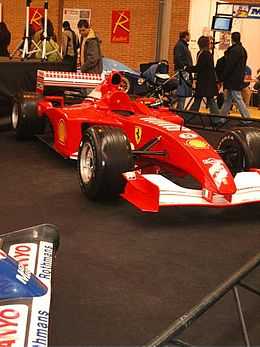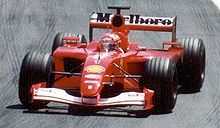Ferrari F2001
 | |||||||||
| Category | Formula One | ||||||||
|---|---|---|---|---|---|---|---|---|---|
| Constructor | Ferrari | ||||||||
| Designer(s) | Rory Byrne | ||||||||
| Predecessor | F1-2000 | ||||||||
| Successor | F2002 | ||||||||
| Technical specifications | |||||||||
| Chassis | Carbon-fibre and honeycomb composite structure | ||||||||
| Suspension (front) | Independent, pushrod-activated, torsion spring | ||||||||
| Suspension (rear) | Independent, pushrod-activated, torsion spring | ||||||||
| Engine | Rear-mounted Ferrari Tipo050 normally aspirated 90-degree V10 | ||||||||
| Transmission | Ferrari seven-speed longitudinal semi-automatic sequential | ||||||||
| Fuel | Shell | ||||||||
| Tyres | Bridgestone | ||||||||
| Competition history | |||||||||
| Notable entrants | Scuderia Ferrari Marlboro | ||||||||
| Notable drivers |
1. 2. | ||||||||
| Debut | 2001 Australian Grand Prix | ||||||||
| |||||||||
| Constructors' Championships | 2001, 2002 | ||||||||
| Drivers' Championships | 2001, 2002 | ||||||||
The Ferrari F2001 was a highly successful Formula One car, designed by Ross Brawn and Rory Byrne for the 2001 Formula One season. A revised version was used in the first two races of 2002 before being replaced by the F2002.

The F2001 was designed around new regulation changes which mandated a higher-mounted front wing assembly to reduce downforce. This resulted in a distinctive 'droopsnoot' nose section and spoon-shaped front wing. The season also saw the re-introduction of traction and launch control systems, therefore the car and its suspension were designed with this in mind.
Being somewhat of a departure over previous Brawn/Byrne Ferrari designs, the car was based more on McLaren's design thinking. However, the car did feature Ferrari trademarks, such as the periscope exhausts pioneered by the team in 1998 and the small bargeboards which were a feature of its predecessors. The F2001 used the same basic gearbox and internal layout as its predecessors, however the aerodynamic efficiency and tyre wear were improved considerably over the F300 (1998), F399 (1999) and F1-2000 (2000).
Setting up the car proved easier, and it was faster than the rival McLaren MP4-16, but the Williams FW23—although aerodynamically inferior—was fitted with the massively powerful BMW engine, which was more than a match for the Ferrari power unit.
The season would turn out to be easy for Michael Schumacher, who took nine victories and his fourth world championship—scoring a then-record 123 points. He failed to finish only twice, but his team-mate Rubens Barrichello had the lion's share of bad luck and looked poised to take wins himself, being hindered only by unreliability. All the while, Ferrari won its third straight constructors' championship.
The car was still competitive at the beginning of the 2002 season and Schumacher took the car's final win at the Australian Grand Prix before it was replaced by the all-conquering F2002 from the third race (only for Schumacher) and fourth race onwards (for Barrichello). Overall, the F2001 took ten wins, thirteen pole positions, three fastest laps and 197 points throughout its lifespan.
Complete Formula One results
(key) (results in bold indicate pole position; results in italics indicate fastest lap)
| Year | Team | Engine | Tyres | Drivers | 1 | 2 | 3 | 4 | 5 | 6 | 7 | 8 | 9 | 10 | 11 | 12 | 13 | 14 | 15 | 16 | 17 | Points | WCC |
|---|---|---|---|---|---|---|---|---|---|---|---|---|---|---|---|---|---|---|---|---|---|---|---|
| 2001 | Ferrari | Ferrari 050 V10 | B | AUS | MAL | BRA | SMR | ESP | AUT | MON | CAN | EUR | FRA | GBR | GER | HUN | BEL | ITA | USA | JPN | 179 | 1st | |
| Michael Schumacher | 1 | 1 | 2 | Ret | 1 | 2 | 1 | 2 | 1 | 1 | 2 | Ret | 1 | 1 | 4 | 2 | 1 | ||||||
| Rubens Barrichello | 3 | 2 | Ret | 3 | Ret | 3 | 2 | Ret | 5 | 3 | 3 | 2 | 2 | 5 | 2 | 15 | 5 | ||||||
| 2002 | Ferrari | Ferrari 050 V10 | B | AUS | MAL | BRA | SMR | ESP | AUT | MON | CAN | EUR | GBR | FRA | GER | HUN | BEL | ITA | USA | JPN | 221* | 1st | |
| Michael Schumacher | 1 | 3 | |||||||||||||||||||||
| Rubens Barrichello | Ret | Ret | Ret |
* 14 points scored with the F2001
External links
| Awards | ||
|---|---|---|
| Preceded by Ferrari F1-2000 |
Autosport Racing Car Of The Year 2001 |
Succeeded by Ferrari F2002 |
| Wikimedia Commons has media related to Ferrari F2001. |
| ||||||
| ||||||